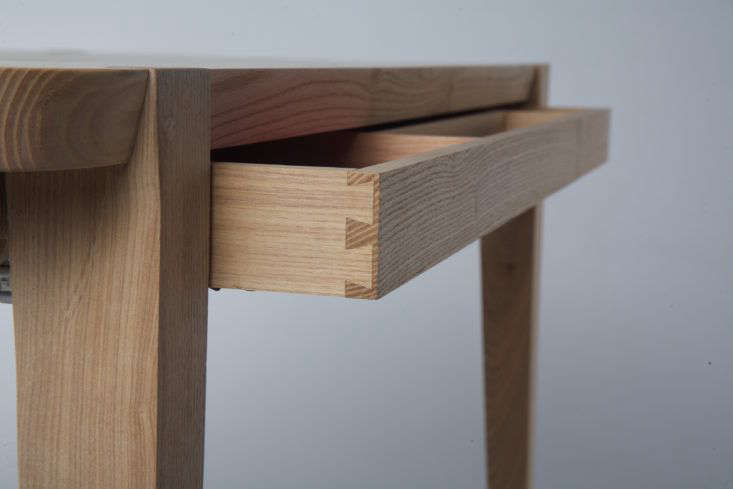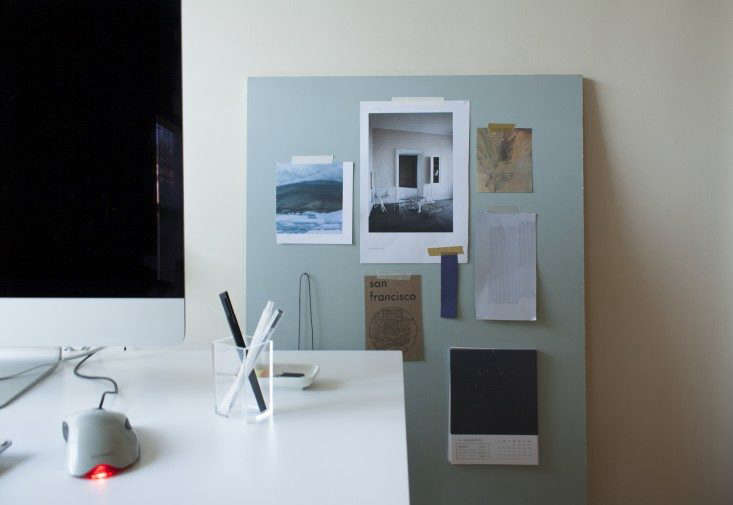
What’s your secret formula for creating order? Over the course of producing our book, Remodelista: The Organized Home—the companion volume to this site—we turned to a range of experts for insider strategies. A kindergarten teacher told us how he gets his students to tidy up after themselves—and how you can apply this approach in your own entryway. A hotelier walked us around the bathrooms in his establishment pointing out where to deploy hooks and how to keep the blow dryer out of site. And a ship designer explained tricks for small space living at sea and on land.
Today, we’re continuing the series by presenting architect Oliver Freundlich’s advice on how to keep your work space orderly and inspiring. If Freundlich’s name sounds familiar that’s because we’re a longstanding fan of his work: we featured his kitchen design for actress Julianne Moore, his sister-in-law, in our first book and have explored many of his projects (find links below). He runs his own busy downtown NYC architecture firm, Oliver Freundlich Design, works from an L-shaped desk, and applies principles learned from his days at the Yale School of Architecture to keeping things organized.

1. Keep a clear desktop.
Limiting your immediate work space to the job at hand enables you to stay focused and on task, says Freundlich, who is always juggling several projects at once. After trying out a range of desks, he found that an L-shape is ideal for him, because it provides a work area, plus “a place for the piles to go.” He keeps an upright file holder on the right side of the L for “receipts, live and active projects, things I go to daily.” Other places for the piles? Read on. (And for digital streamlining advice, read 10 Ways to Declutter Your Tech Experience.)


2. Add a parking place for your phone, keys, and other essentials.
On the back right corner of his desk—off to the side but within easy reach—Freundlich keeps a polished stone sample that he uses as a tray: “When I get to my desk, I take off my watch and my keys and phone out of my pocket and lay them out on this ‘tray’. This is a ritual that signals for me the start of work, and my things are always in the same location, so I know where they are.”

3. Designate at least one drawer for desk supplies.
Freundlich says he tried the streamlined approach and found he missed having a place to keep desk supplies. He now has a single drawer, and says that a small freestanding set of drawers, such as a Bisley Cabinet from the Container Store, also works well. “To keep a clear desktop, you need a place for the paper clips and other small items to go.”


4. Create an old-style pin board for inspiration.
“In the age of Pinterest, it’s still nice to have something tactile pinned to the wall,” says Freundlich. He uses a painted Homasote board in front of his desk, covers it with images, and then “tears it down and starts again.” His firm’s associate interior architect, Emily Lindberg, also curates a changing gallery of desktop images to amuse and inspire the staff.

5. Go with unified storage for a clutter-free look.
“Archiving is a part of life in a busy office,” says Freundlich. ” A periodic reorganization allows you to start afresh and reclaim space.” For records and other paperwork worth holding onto, Freundlich uses archival cardboard Flat Storage Boxes from Light Impressions (and affixes each with a black-and-white Label Maker label). Whatever you select, he recommends using it in multiples: “Uniformity lends an immediate sense of order—it’s far more forgiving than a range of shapes and colors, and it’s aesthetically appealing.”
Tip for parents of prolific young artists: Freundlich uses the app Artkive to keep organized digital records of his daughter’s work. “That was one of the biggest challenges in our house; now we take snapshots.”


6. Splurge on state-of-the-art shelves.
Like all architects—at least the ones we know—Freundlich is a huge fan of Vitsoe’s modular shelving system designed in 1960 by Dieter Rams. “They’re so handsomely designed, they can exist anywhere; they’re made to move with you and to last a lifetime.” At home, instead of a desk, Freundlich has a Vitsoe shelf that incorporates a flat file; he keeps his work-related things in it and uses his dining table as a desk.







Have a Question or Comment About This Post?